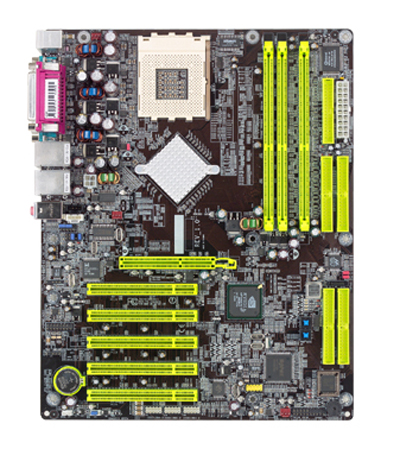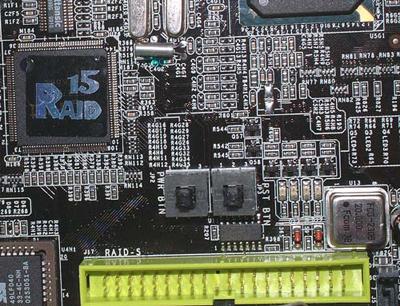DFI NFII Ultra: Mean Green Dream Machine
by Wesley Fink on July 30, 2003 6:25 PM EST- Posted in
- Motherboards
DFI NFII Ultra LanParty: Board Layout
The DFI NFII Ultra, like other LanParty boards, has an excellent layout. We have yet to see the perfect motherboard, however, so we do have a few minor annoyances to report.
More and more top-end AMD motherboards are implementing both the standard ATX 20-pin connector and the 4-pin 12-volt connector that are part of the Pentium 4 Power Supply specification. DFI has provided both connectors on the NFII. The location of the 20-pin is virtually ideal – to the right of the DIMM slots at the top corner. This is a great location for most case designs - even full towers. Although the 4-pin 12V connector is in a common location to the left of the CPU socket we prefer the 12V to the right of the CPU socket between the CPU and DIMM slots, and as close to the top of the board as possible. The DFI worked fine with the single ATX connection, but we ran all benchmarks with both the ATX and secondary 12V connector. The DFI was built for overclocking, and the 12V connector will likely increase board stability in extreme overclocking situations.

It is easy to argue both sides of DFI’s decision to use a huge passive heatsink for the nForce2 Ultra 400 Northbridge. Some will prefer the passive heatsink, while others would prefer active cooling. The proof, in the end, is how effective the solution works. We had no problems whatsoever, even overclocking as high as 228 FSB, with overheating of the heatsink. Please also take note of the cute little heatsink that DFI has applied to the power transistor, below left of the heatsink. This has been a component that often gets hot on other nForce2 boards, and we are happy to see DFI add cooling to this component. It seems to work well and stay reasonably cool.
One concern with a large passive heatsink, particularly those mounted diagonally like the nFoece2 boards, is whether large heatsinks will fit. The Thermalright SK-7, which uses a clip for connection, fit with no problem at all – even with an 80mm fan attached. However, there are no mounting holes around the CPU socket, which will be important to some. Several water-cooling blocks and a few very large heatsinks require the four mounting holes for proper setup. The mounting holes are not part of the current AMD specification, but boards targeting the enthusiast market would do well to include the mounting holes to avoid customer disappointment.
The Floppy connector and Primary/Secondary IDE connectors are in the ideal position - closer to the top of the board and to the right of the DIMM slots. This will allow IDE cables to reach the upper bays of almost any case design. Depending on your case design, you will either love or hate the IDE RAID connector locations. If you have a case with drive bays to the right of the motherboard, the location at the bottom right of the board will seem ideal. If your hard drives must mount in the upper bays of a tower case, you will probably wonder what DFI was thinking in their design. For the majority of case designs, the lower right location for hard-drive-only connections makes more sense.

Abit received a lot of positive comments when they began putting momentary power and reset switches on their top-line overclocking boards. Everyone raved about this nice touch for the serious computer hobbyist. Well, good ideas tend to get adopted by others, and DFI has included push-button Power and Reset switches on the NFII Ultra. In fact, DFI is using the switches as part of their signature design for the LanParty boards. The onboard switches are just another touch to let the end-user know that this is a board designed for serious computer users.










46 Comments
View All Comments
Anonymous User - Thursday, July 31, 2003 - link
Anyone else having a problem seeing the images containing benchmark results? The Gigabyte board review had the same problem.Anonymous User - Thursday, July 31, 2003 - link
>Besides, nvidia is no longer the standard for performance, in fact they are becoming the (Trident) of the video card market.Can you say "drooling ATI fanboy"? I knew you could!
Anonymous User - Thursday, July 31, 2003 - link
errr that should be "new" not "knew" in comment 16....i'm sure i misspelled some other things too, which y'all are welcome to point outAnonymous User - Thursday, July 31, 2003 - link
hey guys as wesley stated, he's knew to AT...let's give him some constructive criticism - preferably in as nice a way as possible ;)to wesley, please don't take the comments here the wrong way - i think everyone here just wants to see quality reviews here and really are trying to be constructive, even if it doesn't really sound like it all the time ;) you have high standards to live up to at anandtech and when ya slip, they're gonna let ya know ;)
Anonymous User - Thursday, July 31, 2003 - link
I think you guys are being a bit hard on this review. Granted posting benchmarks comparing 2 different motherboards with 2 different video cards is just wrong but give them a chance to fix it.Sammual
Anonymous User - Thursday, July 31, 2003 - link
Anandtech is starting to lose my respect! Were you guys payed to make the board look good?If the video cards aren't the same then there should be no gaming benchmarks!
Peace
Anonymous User - Thursday, July 31, 2003 - link
I completly agree with number 8 above, there are a few primary boards that are the most popular, ASUS and EPOX being the main ones. I personally do not know anyone that uses a gigabyte nforce2 based board for their AMD chips. Heck that Gigabyte board you tested with was not even a consideration when I was looking for my nforce board.Besides the proofing issues involved in this article, it just would have been nice if you used the top tier of nforce boards as a comparison.
Also, why on earth are you guys still using nvidia based video cards for testing purposes????
In your attempt to keep us up to date and advised properly on new products and specially benchmarks, you should atleast keep your hardware up to date. Besides, nvidia is no longer the standard for performance, in fact they are becoming the (Trident) of the video card market.
Evan Lieb - Thursday, July 31, 2003 - link
Jeff7181,It's already been proven that nForce2 Ultra 400 motherboards are faster than KT600 motherboards. This DFI review wasn't meant to prove that again.
Yes, this review used the 9800 Pro instead of our usual Ti4600. We're sorry about that, as we're currently transitioning our motherboard testbeds. Be patient and you'll find data comparing KT600 and nForce2 Ultra 400 boards using a 9800 Pro like we normally do.
Take care,
Evan
Odeen - Thursday, July 31, 2003 - link
Once again, we have fluff on the PCI bus that doesn't belong there... Why not just put a PHY that implements the 3Com MAC on the southbridge, instead of stealing PCI bandwidth and adding extra componentry.As awful ad 3com drivers might be, they still beat the processor hogging "win-NIC" that is Realtek.. The only saving grace is the use of the Cmedia codec for the Soundstorm. While not on par with Asus' implementation of the A7N266-C (ACR card with Sigmatel codecs, as far away from the motherboard as possible), it at least beats the godawful ALC650..
(Before you jump on me with the Dolby encoding. DD is LOSSY as well, if you read 3dsoundsurge review of the Soundstorm audio, you'll find out that in DD encoding mode, you lose all frequencies over 18,000).. Granted, with all the fans yer average overclocker has, they don't really have the hearing to experience 18,000 hz, but it's still nice to know it's there :)
Anonymous User - Thursday, July 31, 2003 - link
I would like to add a point about the exclusion of gigabit lan on the DFI NFII Ultra LanParty mainboard. Although gigabit lan would be a nice feature for an enthusiast, adding gigabit lan in place of dual megabit lan would alter nVidia's original marketing strategy for the NForce 2 chipset. Remember nVidia was touting "DualNet" as a great feature of NForce 2? Well, here is a reminder:"DualNet
Part of the nForce2 Digital Media Gateway. DualNet is integrated support for an NVIDIA Ethernet Mac and for a 3Com® Ethernet Mac—allowing a PC to serve as a home gateway, managing traffic between two separate networks and ensuring rapid transfer of data from WAN to LAN without any added arbitration or latency."
So, DFI was just following along with the nVidia strategy. Besides, where are you going to put gigabit lan on this board? On the pci bus? You would saturate it. You need some bus which can handle a minimum of 133 MB/s throughput, like CSA, to get the full benefit of gigabit lan.